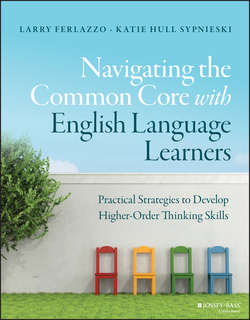Читать книгу Navigating the Common Core with English Language Learners - Sypnieski Katie - Страница 8
На сайте Литреса книга снята с продажи.
Chapter One
English Language Learners and the Common Core: An Overview
ОглавлениеChange is the law of life. And those who look only to the past or present are certain to miss the future.
– John F. Kennedy3
Change is a constant in life, and this is especially true in education. When faced with change some people cling strongly to the past, others dive in headfirst without question, and some take a more measured approach by evaluating both past and present as they move forward.
In terms of education, it is important to look to past research on effective teaching and learning, but not to cling to outdated, ineffective practices. It is also important to be in the present, the era of “Common Core,” and to try new strategies, while not ignoring what we already know about good teaching practice.
When teaching English Language Learners, we need to evaluate current standards and consider how to teach them in light of what has already been learned about language acquisition. In our classrooms, we acknowledge our students for who they are in the present – getting to know their interests, assessing their current proficiency levels, and identifying their academic strengths and challenges. But, we also look to their past – inviting them to share the prior knowledge and rich experiences they bring with them.
It is this balance – looking at both past and present in order to shape the best future – that we hope will be apparent in this book, and particularly in this chapter. We start with an overview of general information related to teaching ELLs. While many of the topics in the first few pages are similar to those in our first book, The ESL/ELL Teacher's Survival Guide,4 the information has been updated with recent research and demographics. Of course, the biggest change since we wrote our first book 4 years ago is the implementation of the national Common Core standards and new state English Language Proficiency standards occurring throughout the country. While many of the strategies outlined in our last book are compatible with Common Core, we've learned a lot in the past 4 years.
In this book, we will explain how we've used the Common Core standards to improve some of the ideas from our last book while also laying out new strategies we are using to help our students meet the challenges of Common Core. Obviously, it is not realistic for early Beginners to meet grade-level Common Core standards. However, the strategies for Beginning ELLs described in our first book and further developed in this book, lay the groundwork for them to do so as quickly as possible. For example, the pattern-seeking strategies in the Picture Word Inductive model5 help prepare them for the pattern-seeking needed in the close reading required by Common Core. The use of Text Data Sets helps students develop preliminary essay writing skills as they organize and summarize categories. In addition, the dialogues we use with Beginners prepare students for the communicative tasks in the Speaking and Listening Common Core Standards, and the many vocabulary activities described for Beginners in our first book set the stage for the acquisition of the academic vocabulary required in the Language standards.
3
Kennedy, J. F. (1963, June 25). John F. Kennedy: Address in the Assembly Hall at the Paulskirche in Frankfurt. The American Presidency Project. Retrieved from http://www.presidency.ucsb.edu/ws/index.php?pid=9303
4
Ferlazzo, L., & Hull Sypnieski, K. (2012). The ESL/ELL teacher's survival guide: Ready-to-use strategies, tools, and activities for teaching all levels. San Francisco, CA: Jossey-Bass.
5
Ferlazzo, L., & Hull Sypnieski, K. (2012). The ESL/ELL teacher's survival guide: Ready-to-use strategies, tools, and activities for teaching all levels (p. 41). San Francisco, CA: Jossey-Bass.
